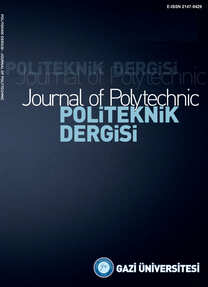İnsan Kolon Kanseri Hücrelerine Karşı İnorganik Nanopartikül-Temelli İlaç Taşıyıcı Sistemlerin Kullanılması: Partikül Büyüklüğünün Antikanser Aktivitesine Etkisi
İlaç taşıma sistemleri, partikül boyutu, kolon kanseri, Caco-2 hücreleri, HCT-116 hücreleri
Using Inorganic Nanoparticle-Based Drug Delivery Systems against Human Colon Cancer Cells: Effect of Particle Size on Anticancer Activity
Drug delivery systems, particle size, colon cancer, Caco-2 cells, HCT-116 cells,
___
- [1] Müller R. H, Jacobs C. and Kayser O., “Nanosuspensions as particulate drug formulations in therapy: Rationale for development and what we can expect for the future”, Adv Drug Deliv Rev., 47: 3–19, (2001)[2] Jaracz S., Chen J., Kuznetsova L. V. and Ojima I., “Recent advances in tumor-targeting anticancer drug conjugates”, Bioorg. Med. Chem., 13: 5043–5054, (2005) [3] Müller R. H. and Peters K., “Nanosuspensions for the formulation of poorly soluble drugs: I. Preparation by a size-reduction technique”, Int J Pharm., 160: 229–237, (1998)[4] Rizzo L. Y., Theek B., Storm G., Kiessling F. and Lammers T., “Recent progress in nanomedicine: therapeutic, diagnostic and theranostic applications”, Curr. Opin. Biotechnol., 24: 1159–1166, (2013)[5] Shapira A., Livney Y. D., Broxterman H. J. and Assaraf Y. G., “Nanomedicine for targeted cancer therapy: towards the overcoming of drug resistance”, Drug Resist Updat., 14: 150–163, (2011)[6] Sun C., Lee J. S. and Zhang M., “Magnetic nanoparticles in MR imaging and drug delivery”, Adv Drug Deliv Rev., 60: 1252–1265, (2008)[7] Park J. H., von Maltzahn G., Ruoslahti E., Bhatia S. N. and Sailor M. J., “Micellar hybrid nanoparticles for simultaneous magneto-fluorescent imaging and drug delivery”, Angew Chem Int Ed Engl., 47: 7284−7288, (2008)[8] Sykes E. A., Chen J., Zheng G. and Chan W. C., “Investigating the Impact of Nanoparticle Size on Active and Passive Tumor Targeting Efficiency”, ACS Nano., 8: 5696−706, (2014)[9] Danhier F., Feron O. and Préat V., “To exploit the tumor microenvironment: passive and active tumor targeting of nanocarriers for anti-cancer drug delivery”, J. Control. Release, 148: 135–146, (2010)[10] Laurent S., Forge D., Port M., Roch A., Robic C., Elst L. V. and Muller R. N., “Magnetic iron oxide nanoparticles: synthesis, stabilization, vectorization, physicochemical characterizations, and biological applications”, Chem. Rev., 108: 2064–2110, (2008)[11] Uchiyama K., Nagayasu A., Yamagiwa Y., Nishida T., Harashima H. and Kiwada H., “Effects of the size and fluidity of liposomes on their accumulation in tumors: A presumption of their interaction with tumors”, Int. J. Pharm., 121: 195–203, (1995)[12] Nagayasu A., Shimooka T., Kinouchi Y., Uchiyama K., Takeichi Y. and Kiwada H., “Effects of fluidity and vesicle size on antitumor activity and myelosuppressive activity of liposomes loaded with daunorubicin”, Biol Pharm Bull., 17: 935–939, (1994)[13] Nagayasu A., Uchiyama K. and Kiwada H., “The size of liposomes: a factor which affects their targeting efficiency to tumors and therapeutic activity of liposomal antitumor drugs”, Adv Drug Deliv Rev., 40: 75–87, (1999)[14] Gao J. H., Gu H. W. and Xu B., “Multifunctional magnetic nanoparticles: design, synthesis, and biomedical applications”, Acc. Chem. Res., 42: 1097−1107, (2009)[15] Lee J. E., Lee N., Kim H., Kim J., Choi S. H., Kim J. H., Kim T., Song I. C., Park S. P., Moon W. K. and Hyeon T., “Uniform mesoporous dye-doped silica nanoparticles decorated with multiple magnetite nanocrystals for simultaneous enhanced magnetic resonance imaging, fluorescence imaging, and drug delivery”, J. Am. Chem. Soc., 132: 552−557, (2010)[16] Daglioglu C. and Okutucu B., “Synthesis and characterization of AICAR and DOX conjugated multifunctional nanoparticles as a platform for synergistic inhibition of cancer cell growth”, Bioconjug. Chem., 27: 1098−1111, (2016) [17] Daglioglu C., “Enhancing tumor cell response to multidrug resistance with pH-sensitive quercetin and doxorubicin conjugated multifunctional nanoparticles”, Colloids Surf. B Biointerfaces, 156: 175–185, (2017)[18] Daglioglu C., “Environmentally responsive dual-targeting nanoparticles: improving drug accumulation in cancer cells as a way of preventing anticancer drug efflux”, J. Pharma. Sci., 107: 934-941, (2018)[19] Russell-Jones G., McTavish K., McEwan J., Rice J. and Nowotnik D., “Vitamin-mediated targeting as a potential mechanism to increase drug uptake by tumors”, J. Inorg. Biochem., 98: 1625–1633, (2004)[20] Daglioglu C. and Okutucu B., “Therapeutic effects of AICAR and DOX conjugated multifunctional nanoparticles in sensitization and elimination of cancer cells via survivin targeting”, Pharm. Res., 34: 175−84, (2017)[21] Daglioglu C., “İlaç Taşıma Sistemleri olarak Nanopartiküller kullanılarak Pasif ve Aktif Tümör Hedeflemelerinin Karşılaştırmalı İncelenmesi”, Akademik Platform Mühendislik ve Fen Bilimleri Dergisi, 6: 01-07, (2018)
- ISSN: 1302-0900
- Yayın Aralığı: Yılda 4 Sayı
- Başlangıç: 1998
- Yayıncı: GAZİ ÜNİVERSİTESİ
AHP Yöntemi Kullanarak Alışveriş Merkezleri Performans Kriterleri Analizi Üzerine Bir Çalışma
Emine Elif NEBATİ, İsmail EKMEKÇİ
Üretim Ortamında FUCOM Yönteminin Bulanık Uygulamaları
A Monte-Carlo Simulation for the Estimation of Side-by-Side Loading Events on Oregon Bridges
Arcan YANİK, Christopher HİGGİNS
A Study On Shopping Malls Performance Criterias Analysis Using AHP Method
Emine Elif NEBATİ, İsmail EKMEKÇİ
Kule Tipi Yapıların Dinamik Davranışının Belirlenmesi: Kırklareli Hızırbey Camii Minaresi
İsmail KILIÇ, Kanat Burak BOZDOĞAN, Süleyman AYDIN, Saadet Gökçe GÖK, Safiye GÜNDOĞAN
Kadir GÖK, Sermet İNAL, Arif GÖK
H. Süleyman GÖKÇE, Hojjat HOSSEİNNEZHAD, Onur ÜZÜM, Daniel HATUNGİMANA, Kambiz RAMYAR
Kambiz RAMYAR, H. Süleyman GÖKÇE, Hojjat HOSSEİNNEZHAD, Onur ÜZÜM, Daniel HATUNGİMANA
